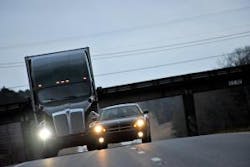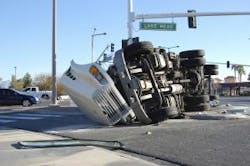If an autonomous or driverless vehicle is involved in a crash, who—or perhaps more precisely what—is held liable? Fleet managers will have many a sleepless night trying to come up with an answer.
Well, experts at the nonprofit research group Rand Corp. delved into this question and came away with some very surprising answers. For starters, the group’s researchers determined that equipping cars and light vehicles with autonomous vehicle (AV) technology would likely reduce crashes, energy consumption, and costs associated with traffic congestion. In essence, AV technology would significantly lower the cost impact of vehicle operations across a variety of fronts.
The National Safety Council reports that in 2011, over 5.3 million automobile crashes occurred in the U.S., resulting in more than 2.2 million injuries and 32,000 fatalities. Those incidents resulted in $871 billion in economic loss and societal harm. But the Insurance Institute for Highway Safety (IIHS) estimates that if all vehicles had forward collision and lane departure warning systems, side-view (blind spot) assist, and adaptive headlights—all components of AV systems—nearly one-third of those crashes and fatalities could have been prevented.
Rand notes that 39% of crash fatalities in 2011 involved alcohol and AV systems could also have negated some of those crashes. The firm calculates every additional driver increases congestion for all other drivers and increases the chance that another driver will have an accident. Those “externalities” are estimated to cost about 13¢/mi., Rand says. So, if a person drives 10,000 mi., he or she imposes $1,300 worth of costs on others. The group also determined that such driverless technology isn’t infallible and policy accommodations must be made to account for that.
In general, the group found that robotic systems, including AVs, rely on a “sense-plan-act” design. In order to sense the vehicle environment properly, AVs use a combination of sensors including light detection and ranging systems, radar, cameras, ultrasonic, and infrared technology. Rand’s research found that a suite of sensors in combination can complement one another and make up for any weaknesses in any one kind of sensor.
Reducing risk
While robotic systems are very good at collecting data about the environment, making sense of that data remains probably the hardest part of developing an ultra-reliable AV. For instance, AVs typically rely on a combination of global positioning system (GPS) and inertial navigation system (INS) data, but an error of up to a meter or nearly 3 1/2 ft. can occur in a 10-second period during which the system relies on INS.
In order to permit autonomous operation without an alert backup driver at the ready, AV technology needs to “degrade gracefully,” in the words of Rand’s researchers, in such a way that a catastrophe is avoided. For example, if some element of the system fails in the middle of a curve in busy traffic, there must be a sufficiently robust backup system so that even with the failure, the vehicle can maneuver to a safe stop.
But what if it doesn’t? And what if that failure causes a crash? This is where things get tricky. On the one hand, Rand Corp.’s researchers found that the existing liability regime does not seem to present unusual concerns for owners or drivers of vehicles equipped with AV technologies.
On the contrary, the decreased number of crashes—potentially of over a third, IIHS notes—and associated lower insurance costs that AV technologies are expected to generate should encourage drivers and automobile-insurance companies to adopt such systems.
Rand Corp. cautions that its research indicates manufacturer product liability may increase via the use of AV systems since drivers themselves are not in control of the vehicles.
The group believes one potential solution to this problem is to more fully integrate a cost-benefit analysis into the standard for liability in a way that accounts for consideration of the associated benefits.
Manufacturers may also be able to reduce these risks by changing the business model of vehicle manufacturing, e.g., offering the use of an automobile as a service rather than a product. Another approach would be for manufacturers to use technology for closer monitoring of driver behavior.
This is where policymakers could step in, Rand Corp. notes. These might be addressed by a variety of approaches at the Congressional level, including tort pre-emption; a federal insurance backstop; the incorporation of a long-term cost-benefit analysis in the legal standard for reasonableness; or an approach that continues to assign liability to the human operator of the vehicle.
That last option would also involve the U.S. legal system. It is known as an “irrefutable presumption of human control” for vehicles to preserve the existing convention that a human driver is legally responsible for a vehicle, whether or not AV technology is engaged.
The role of regulators also gets muddied in all of this, notes Rand Corp. Historically, the firm says, vehicle performance is tested by the National Highway Transportation Safety Administration (NHTSA), while driver performance is tested by state Dept. of Motor Vehicle offices. However, since AV technology is literally “the driver” of a vehicle, the traditional division of such oversight roles could become very complicated, say researchers at Rand Corp.
James Burnley, who co-chairs the transportation practice at law firm Venable LLP in Washington, D.C., and served as U.S. secretary of transportation from 1987 to 1989, believes NHTSA regulators will proceed cautiously regarding the wider use of AV technology.
“It’ll be a very careful balancing act,” he explains. “Regulators don’t want to stifle innovation, especially innovation like driverless technology that could save lives, but they must also guarantee as much as possible any system put on a vehicle is safe.”
Sustaining safety
Burnley believes a “gradual deployment” of AV technology will most likely occur over a time span of several years, mirroring how DOT dealt with the introduction of airbag systems in the 1980s.
“To the extent technology can be shown to save lives, you need to leave the development door wide open,” he said. “Yet you also need to carefully examine the testing data from [AV] technology tests. When you are talking about cars and trucks operating without drivers, you need to be careful to ensure the safety of the motoring public is maintained.”
Overregulation also poses risks, Rand Corp.’s researchers note, as state legislative attempts to regulate AV technology could result in a “crazy quilt” of incompatible requirements and regulations that would make it impossible to operate a vehicle with this technology in multiple states.
“Overall, the guiding principle for policymakers should be that AV technology ought to be permitted if and when it is superior to average human drivers,” according to Rand Corp.’s researchers.
“For example, safety regulations and liability rules should be designed with this overarching guiding principle in mind,” they add. “Similarly, this principle can provide some guidance to judges struggling with whether a particular design decision was reasonable in the context of a product’s liability lawsuit.”
Forrest Burnson, market research associate with consulting firm Software Advice, points out that a recent survey his company conducted among 385 U.S. adult drivers found that sharing the road with driverless trucks is not a welcome idea. Results of the survey include the following:
- Over two-thirds of the respondents polled by the firm said they would feel “less safe” sharing the road with driverless semi-trucks, while 56% believed driverless cars would be “less safe.”
- Women were more likely than men to think that vehicles piloted by driverless technology would be less safe than vehicles operated by human beings.
- The majority of respondents would be uncomfortable with driverless semi-trucks, even if it meant cheaper consumer products or reduced carbon emissions.
Such attitudes toward the safety of driverless technology poses quite a problem for truck manufacturers as well as the trucking industry as a whole, though not an insurmountable one, notes Alberto Broggi, a professor of computer engineering at the University of Parma in Italy who specializes in driverless technology research.
“The only thing [manufacturers could do] would be to demonstrate a lower probability of accidents,” he says. “But this is the usual problem, and it is very difficult to achieve, since an accident is not a frequent event [and] it will take years of widespread use of driverless technology to collect meaningful data on accident rates.”
It is Broggi’s view that it will be some time before manufacturers can use hard evidence to assuage the public’s concerns regarding driverless technology—and by extension help reduce their liability as well.
About the Author
Sean Kilcarr
Editor in Chief
Sean Kilcarr is a former longtime FleetOwner senior editor who wrote for the publication from 2000 to 2018. He served as editor-in-chief from 2017 to 2018.


